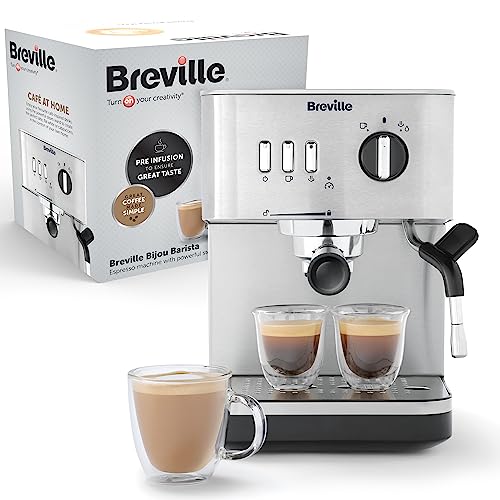Espresso Maker - A Must-Have For Home Baristas
Espresso is a strong dark-brown beverage that is made by pushing hot water through finely packed, tightly ground coffee. It is the basis for numerous popular café drinks.
A barista, also referred to as an "espresso maker" controls a number of variables to make a fantastic cup. This includes the temperature of the water and its pressure as well as how tightly packed the coffee is.
Origins

The espresso machine is a gadget which makes use of high pressure to push small amounts of water near boiling through finely ground beans. The resultant beverage is stronger than drip coffee, and is more concentrated and served in smaller cups. It's a great option for those who love an intense cup of joe but are in a hurry!
In the 19th century, the first espresso machines were invented. The coffee industry was a huge business but the process of making it took too long. Everyone was hungry for an instant cup!
Angelo Moriondo of Turin patented one of the first coffee machines in 1884. The machine's name was "New steam machinery, for the economical and instantaneous preparation of coffee beverages. Method A." Moriondo."
The Milanese manufacturers Luigi Bezzerra and Desiderio Pavoni adapted and improved on this machine. They added the portafilter, multiple brewheads and other innovations that are used in espresso machines today. The Ideale was their machine and it was a hit with the crowd at the 1906 Milan Fair. Nine out of 10 Italian homes have a Moka Pot.
Variations
Espresso's flavor is more intense than coffee, which is why it works well with milk and other ingredients to create delicious coffee drinks such as cappuccinos and lattes. Its strong flavor is evident in recipes for baked goods as well as marinades and other dishes.
There are four types of espresso maker: manual lever semi-automatic, automated, and super-automatic machines. Each model uses a unique method of extracting espresso.
A manual lever machine operates by using a piston to push water through ground. It's a good alternative to human control and mechanized accuracy. You'll still need to grind and tamp shot but you can manage water temperature and pressure much more effectively.
Moka pots are a second manual espresso maker that functions similar to modern pump-driven espresso machine. Inside an airtight tank, boiling water produces steam, which is then pushed through the bottom chamber into a filter basket with ground coffee and into a filter made of metal, where it is then pumped into the top cup. They're less expensive than a full-sized espresso machine, but they're able to only hold up to 1-1.5 bars of pressure, which is lower than the ideal for making espresso.
Ingredients
Espresso makers can help baristas at home make cafe-style drinks such as cappuccinos and lattes. You can also add flavorful extracts or syrups to espresso shots for an indulgence like the espresso martini.
For a great espresso drink you'll need top-quality beans, fresh milk and sugar. Make sure you choose beans that are specially labeled for espresso, and then grind them with precision to ensure a consistent extraction. You can try different roasts until finding the one that is perfect for your preferences.
You'll require a burr mill to grind the beans to an even texture. The espresso machine also comes with a portafilter, which holds the grounds as well as an tamper that is used to compact the coffee.
You'll also need an espresso cup set, as well as steamer to make the silky aerated-milk characteristic of espresso drinks. Some machines have steam wands built-in which makes this step easier and faster. You'll also have to regularly descale the machine. This involves running an aqueous solution of vinegar and water through the system.
Techniques
Espresso brewing relies on the creation of pressure to quickly extract intense flavor from finely ground, dark-roasted, and tightly packed coffee into a 'puck. This method of brewing creates an intense coffee shot, referred to as espresso. If done correctly espresso has a rich crema (or dense foam) on top.
Most espresso makers use high-pressure water to force through finely ground coffee with high temperatures. This is different from the Moka Express, which uses heat to filter out coarsely ground coffee. This makes an espresso-like beverage that is diluted with milk or water to make other beverages, such as cappuccinos or lattes.
While the Moka Express is a simple inexpensive appliance, there are other espresso machines are more complex expensive, and come with numerous drinks to choose from. Click In this article , however, are Italian-designed lever machines that use spring-loaded arms to dispense hot water from a cylinder to the portafilter. The barista is able to adjust variables like water temperature and grind size shot-by-shot to get the best results. These machines were key in bringing espresso to greater recognition across Italy and Europe.
Equipment
A high-quality espresso machine should be able to extract soluble and non-soluble solids out of finely ground tightly packed coffee. This process is made simpler by the use of pressure and controlled variables like temperature and grind size. The flavor also is a result of a myriad of factors, including the beans used and the way they are made.
There are various kinds of espresso machines, however the semiautomatic is most commonly used. It makes use of an electric pump to force the water through the grounds. It also permits users to do the grinding and tamping. These machines are the most affordable, but they're not as reliable as spring pistons or other manual designs.
The higher priced lever models come with an accurate piston that does the work for you. These machines are more forgiving than spring piston machines but they still require a certain amount of skill to operate properly. These machines require a lot more maintenance. It is necessary to warm up the portafilter and take apart the portafilter and the piston each time.
